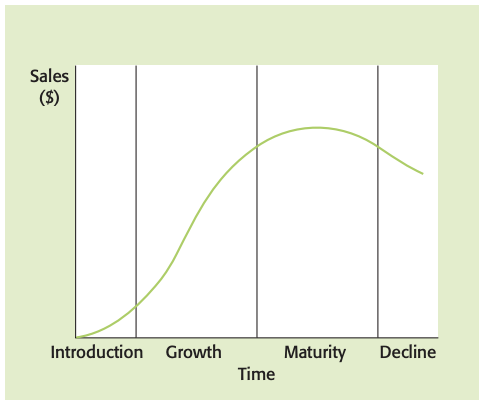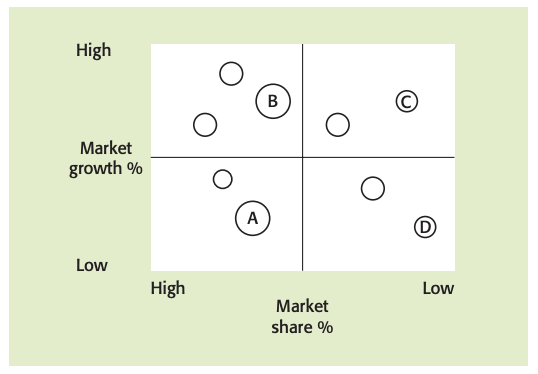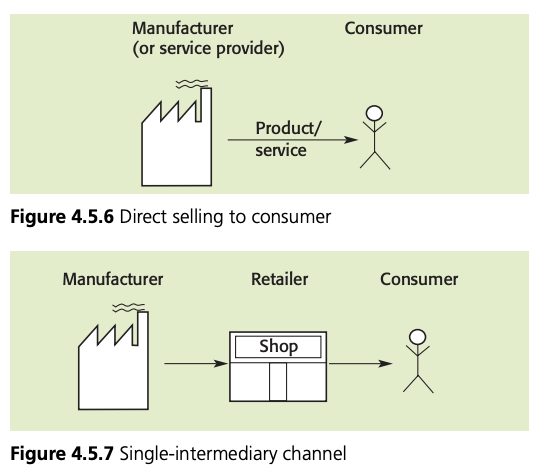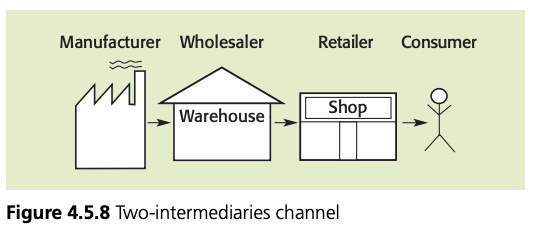4.5 The four 4Ps: product, price, promotion & place
Introduction - product
Product: end result of the production process sold on the market to satisfy a customer need.
Consumer durables: manufactured products that can be reused and are expected to have a reasonably long life, such as cars.
Product life cycle
Product life cycle: pattern of sales recorded by a product from launch to withdrawal from the market.
Stages:
Introduction is when the product has just been launched after development and testing. Sales are often quite low to begin with and may increase only quite slowly but there are exceptions, such as a newly launched DVD by a major rock star.
Growth: if the product is effectively promoted and well received by the market, then sales should grow significantly. This stage cannot last forever, although all firms wish that it would. Eventually, and this may take days, weeks or even years, sales growth will begin to slow and might stop altogether, which leads the product into the next stage. The reasons for declining growth include increasing competition, technological changes making the product less appealing, changes in consumer tastes and saturation of the market.
Maturity or saturation: sales fail to grow, but they do not decline significantly either. This stage can last for years, for example Coca-Cola. The saturation of consumer durables markets is caused by most consumers who want a certain product having already bought one.
Extension strategies: marketing plans that extend the maturity stage of the product before a brand new one is needed.

Boston Consulting Group matrix - product portfolio analysis
Boston Consulting Group (BCG) matrix: method of analyzing the product portfolio of a business in terms of market share and market growth.
Low market growth - high market share: product A “cash cow”
This is a well-established product in a mature market. Typically, this type of product creates a high positive cash flow and is profitable. Sales are high relative to the market and promotional costs are likely to be low, as a result of high consumer awareness.
High market growth - high market share: product B “star”
This is clearly a successful product as it’s performing well in an expanding market because of this it is often called a “star”. The firm will be keen to maintain the market position of this product in what may be a fast-changing market therefore, promotional costs will be high to help differentiate the product and reinforce its brand image.
High market growth - low market share: product C “problem child”
It consumes resources, but it generates little return at least in the short-term. If it’s a newly launched product, it’s going to need heavy promotional costs to help it become established - this finance could come from the cash cow.
Low market growth - low market share: product D “dog”
“Dogs” seem to offer little to the business either in terms of existing sales and cash flow or future prospects, because the market is not growing. They may need to be replaced shortly or the firm could decide to withdraw from this market sector altogether and position itself into faster-growing sectors.

Branding
Brand: identifying symbol, name, image or trademark that distinguishes a product from its competitors.
Brand awareness: extent to a which a brand is recognized by potential customers and is correctly associated with a particular product can be expressed as a percentage of the target market.
Brand loyalty: faithfulness of consumers to a particular brand as shown by their repeat purchases irrespective of the marketing pressure from competing brands.
Brand development measures the infiltration of a product’s sales, usually per thousand population; if 100 people in 1000 buy a product, it has a brand development of 10.
Brand value (or brand equity): premium that a brand has because customers are willing to pay more for it than they would for a non-branded generic product.
Importance of branding
Promotes instant recognition of the company and product
Helps differentiate the company and its products from rivals
Aids in employee motivation
Generates referrals from customers
Customers know what to expect from the company and products
An emotional attachment can develop between the brand and customers, increasing customer loyalty
Increases the value of the business above the value of its physical assets (brand equity).
Types of branding
Family branding: marketing strategy that involves selling several related products under one brand name (also known as umbrella branding).
Product branding: each individual product in a portfolio is given its own unique identity and brand image (also known as individual branding).
Company or corporate branding: company name is applied to products and this becomes the brand name.
Own-label branding: retailers create their own brand name and identity for a range of products.
Manufacturers’ brands: producers establish the brand image of a product or a family of products, often under the company's name.
Importance of packaging
Protection (or function)
Attracting customers
Promotion and information
Differentiation and brand support
Introduction - price
Factors determining the price decision:
Costs of production
Competitive conditions in the market
Competitors’ prices
Marketing objectives
Price elasticity of demand
Whether it’s a new or an existing product
Pricing strategies
Cost-plus pricing: adding a fixed mark-up for profit to the unit price of a product.
Market-based pricing strategies
Penetration pricing: setting a relatively low price often supported by strong promotion in order to achieve a high volume of sales.
Market skimming: setting a high price for a new product when a firm has a unique or highly differentiated product with low price elasticity of demand.
Psychological pricing: setting prices that take account of customers’ perception of value of the product.
Loss leader: product sold at a very low price to encourage consumers to buy other products.
Price discrimination occurs a when a business sells the same product to different consumers at different prices.
Promotional pricing: special low prices to gain market share or sell off excess stock includes '“buy one get one free”.
Price leadership exists when one business sets a price for its products and other firms in the market set the same or similar prices (they “follow suit”).
Predatory pricing: deliberately undercutting competitors’ prices in order to try to force them out of the market.
Introduction - promotion
Promotion: use of advertising, sales promotion, personal selling, direct mail, trade fairs, sponsorship and public relations to inform consumers and persuade them to buy.
Above-the-line promotion
Above-the-line promotion: form of promotion that is undertaken by a business by paying for communication with consumers, e.g. advertising.
Below-the-line promotion
Below-the-line promotion: promotion that is not a directly paid-for means of communication but based on short-term incentives to purchase, e.g. sales promotion techniques.
Sales promotion: incentives such as special offers or special deals directed at consumers or retailers to achieve short-term sales increases and repeat purchases by consumers.
The promotion mix
Promotion mix: combination of promotional techniques that a firm uses to communicate the benefits of its products to customers.
Internet (online) marketing refers to advertising and marketing activities that use the internet, email and mobile communications to encourage direct sales via electronic commerce.
Viral marketing: use of social media sites or text messages to increase brand awareness or sell products.
Guerrilla marketing: unconventional way of performing marketing activities on a very low budget.
“Place” decisions in the marketing mix
Channel of distribution: chain of intermediaries a product passes through from producer to final consumer.
Distribution channels


 Knowt
Knowt